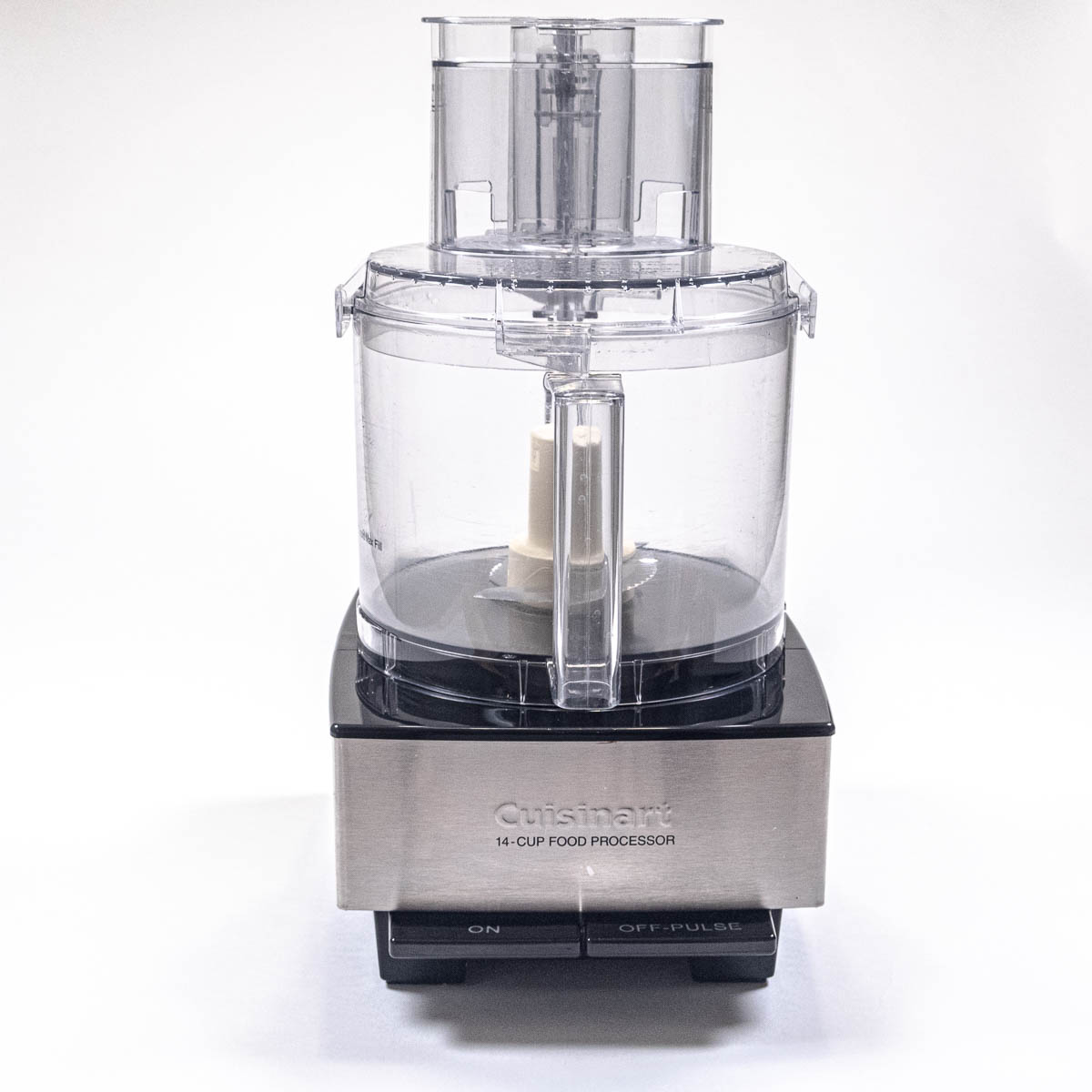
A food processor has played an important part in my life shortly after I decided that food, particularly baking and pastry, would be my life's interest and profession. Very early on in my career, I became a consultant to Cuisinart when it was being introduced to American kitchens.
Carl G. Sontheimer brought the first food processor over from France where it was a tool used by professionals in restaurants. He saw the great potential it had for the home cook and developed his prototype in the garage of his home. The rest, as they say, is history. The original Robo Coupe of France became Cuisinart of America. As Cuisinart grew into a company of home kitchen equipment, it also produced an amazing magazine, "The Pleasures of Cooking". I refer to it as the National Geographic of cooking magazines. It had no advertising, large, beautifully shot photos including how-to photos and, of course, featured recipes using the Cuisinart.
At the time, I was writing for food magazines. I developed my recipe for Croissant cutting the time from days to hours with astounding results. I submitted an article to Cuisinart for their consideration. They not only bought the article but invited me as their guest to a large, prestigious food show in San Francisco to demonstrate my recipe. It was an amazing time. As a result of those few days, Carl invited me to spend time in their test kitchen. A few days became two weeks. After that, I became a consultant to the company.
When I surfed the net looking at what others were saying about this valuable piece of equipment, what I found was everyone made nut-butters, hummus, pesto, mayonnaise, pureed everything and chopped meat. But all too often, the articles used the stainless steel or "S" blade, ignoring the slicing and shredding blades. While these additional blades are not used much at all in baking, there are a ton of uses in cooking. But this is a baking blog.
Many different food processors
When I worked with Cuisinart there was one food processor. It didn't take long for another to come along and then another, etc.etc. Today there are many different brands as well as sizes. Because I use a 14 cup Custom Cuisinart, that is the one I am going to talk about. However, much of this information can be used no matter the machine.
There are also mini processors but they don't have the functionality that the large ones have. I use one for some personal spice blends I make because really small amounts don't work in a processor.
What Comes with the Food Processor
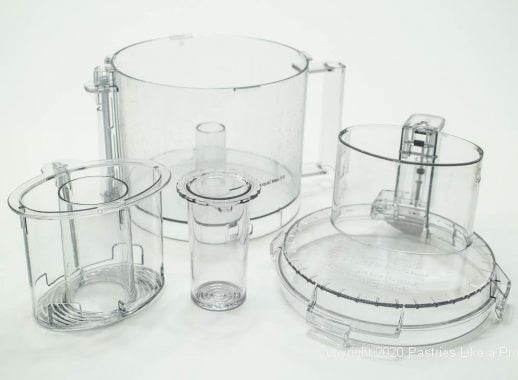
Most processors come with a bowl, top, sleeve, and pusher. A shredding blade, as well as a slicing blade, and a stem on which to place them, is also included. Some include a plastic blade as well.
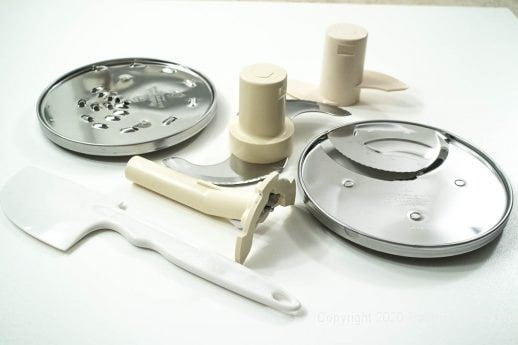
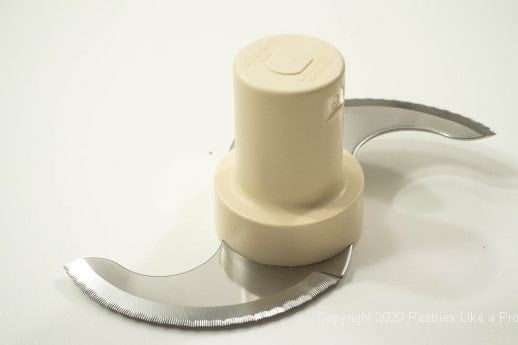
The "S" blade, sometimes referred to as a knife blade because of its ability to cut like a knife is the most used blade. It chops, purees, mixes and is the most used attachment. It's extraordinarily fast and extraordinarily sharp. This blade is used to make sauces, vinaigrettes, mayonnaise as well as salsa's, the aforementioned hummus, pesto, nut-butters, and chopping.
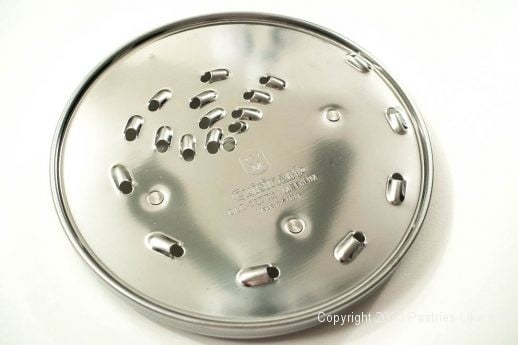
The shredding disc is attached by a stem. It sits at the top of the bowl. It makes quick work of shredding vegetables and can be used wherever a grater is needed. It's great for shredding firm cheese as long as they are cold or partially frozen.
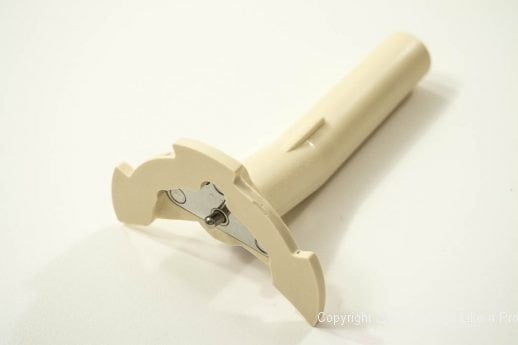
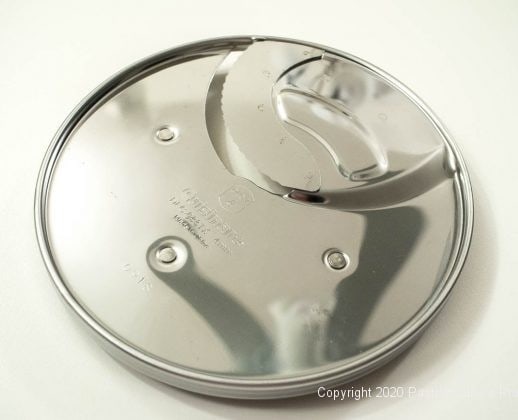
The slicing disc is also attached by a stem and sits at the top of the bowl. It slices veggies as well as some cheese and meat.
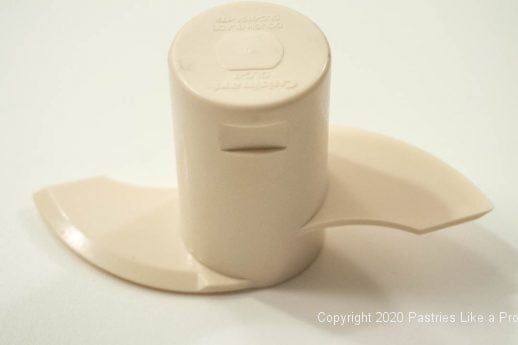
The plastic blade, that looks like the ends of the "S" blade has been cut off is supposed to be used for kneading yeast dough. I don't use this one since I don't see any difference if I use the "S" blade to mix and knead the dough.
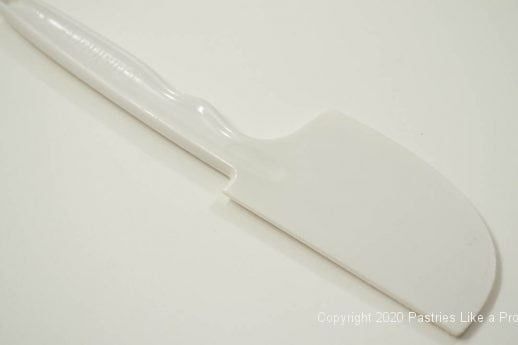
Hard Plastic Spatula. It's important to use this spatula when scraping down the sides. Do not use a softer rubber or plastic spatula as the blade will cut into these.
Cleaning Tool
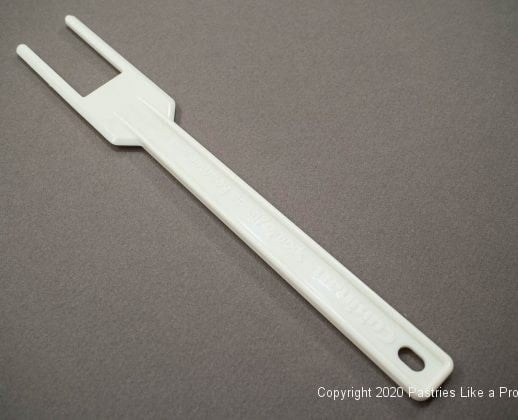
This tool is used to clean the inside of the S blade or the plastic dough blade. When you turn the blade over, you will see a lot of food gets trapped. By inserting this tool, the food can easily be removed and the inside of the blade kept clean.
Useful Tips for using the Food Processor
This model Cuisinart has an on, and an off/ pulse mode. Each of these has its uses.
On mode is used when pureeing, and mixing. This mode keeps the machine running continuously and only stops when off is pressed. If pureeing, it should be run continuously until the desired smoothness is obtained. Depending upon what you are pureeing, it may never be quite as smooth as a blender. Mixing is another thing completely. If using a processor other than this one, check your manual for how much the bowl will hold.
Off/Pulse turns the machine off or allows you to pulse items to control the chopping or the action in the bowl. For instance, if it is being used to chop items, you can control the size by how long you pulse, for a short time or longer, which will vary depending upon the size you want and the item being chopped. Pulsing also helps distribute the ingredients before they form a mass that is too heavy to respond to pulsing.
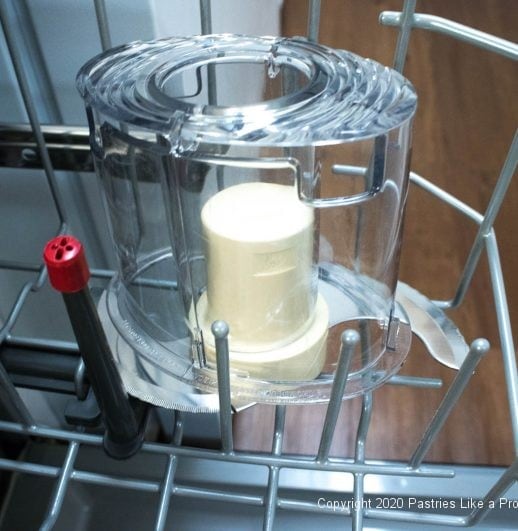
All parts of the processor, except the base, can be cleaned in the dishwasher. (I am speaking of the Cuisinart here). Be sure to place the "S" blade bottom down so the water can penetrate inside the blade to clean it. I protect the blade so no one gets accidentally cut by placing the sleeve over the blade when washing in the machine. It also holds it in place so it can't move around.
Stalling – If the machine stalls at any point, turn it off immediately. Do not try to keep using is since this will burn out the motor. Just turn it off, let it rest briefly and then resume whatever you were doing.
Keeping the S blade from falling out when you are emptying the bowl is easy. Hold the bowl with the blade in it in either hand. Place the middle finger of your hand into the shaft of the blade from the bottom and hold it in place. The bowl can now be turned upside down and the blade won't fall out.
Cleaning food off the Blade - This is especially helpful with some dough, batters, or thicker mixtures. When the contents of the bowl have been emptied, there is always some left on, under and around the blade as well as the bowl. It can be a lot or a little, depending upon what it was used for. By putting the blade back in the processor if it was taken out, or just returning the bowl with the blade to the base just pulse it two or 3 times and the centrifugal force will fling the remains to the side of the bowl. Just remove the now clean blade, and scrape out the remainder.
Food on and around the blade.
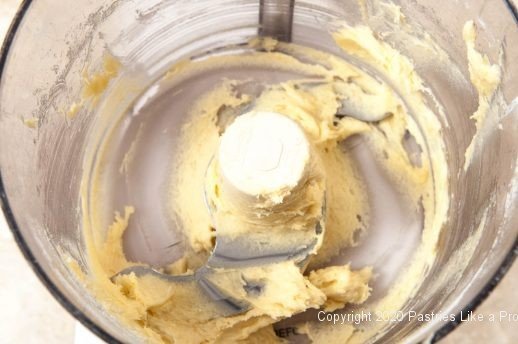
The blade has been cleaned by pulsing it several times.
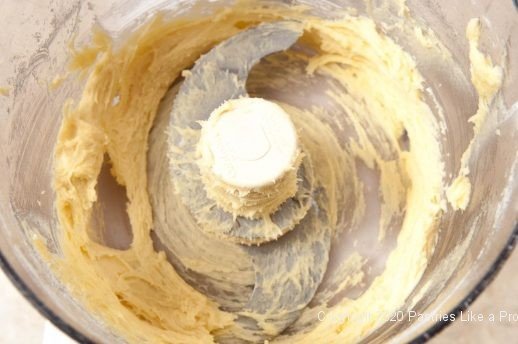
The blade has been removed and the bowl scraped out.
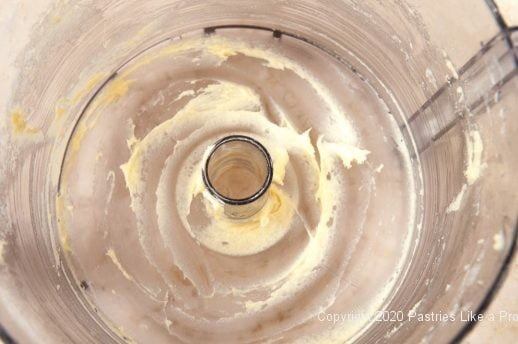
Replacing the S blade – If a lot of hard products such as parmesan, ice, nuts, or anything hard is chopped a lot using the S blade, it can become dull. The blades can't be sharpened but new blades can be purchased, at least with the Cuisinart. While the base of a processor will last almost forever, the blade will not.
Overloading the machine- My work bowl is marked with a line to show me the maximum amount of liquid the bowl will hold. If yours isn't, make sure the ingredients don't go over the top of the blade. Too much liquid in the bowl will cause it to leak out through the shaft making a mess you don't want to have to clean up.
Specific Notes on using Ingredients
Bread - I use the food processor to make yeast bread, both sweet and savory. Although I have heard a lot of reasons for not using the "S" blade for bread, I disagree and have been using it for both the mixing and kneading since I've had one. The plastic blade with the cut off ends is included for making bread but doesn't do the job. I initially mix the ingredients and then process for 30 seconds to knead using the "S" blade. Some doughs will ball up and go around and around in the bowl when kneading them. Others that are softer or more like batter will not ball up but can be kneaded for 30 seconds also. Because of the high speed of the food processor, the bread will be kneaded in much less time than the normal 3 to 4 minutes in a mixer.
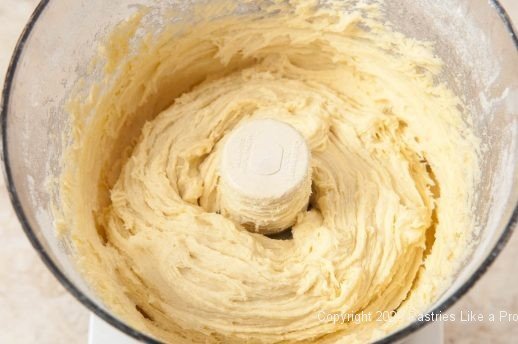
Brioche finished in the processor.
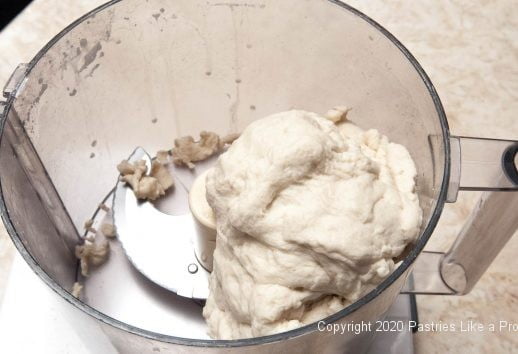
Wine and Cheese Bread finished and balled up.
Butter should be refrigerator cold or frozen if cutting into flour unless otherwise instructed. Room temperature or softened butter will not yield the same results. Cold or frozen butter is necessary for pie crusts or laminated dough where it is left in larger pieces, but it also can be cut in so finely it is indistinguishable when using for other dough that is usually creamed such as shortbreads, press in crusts, cakes, etc.
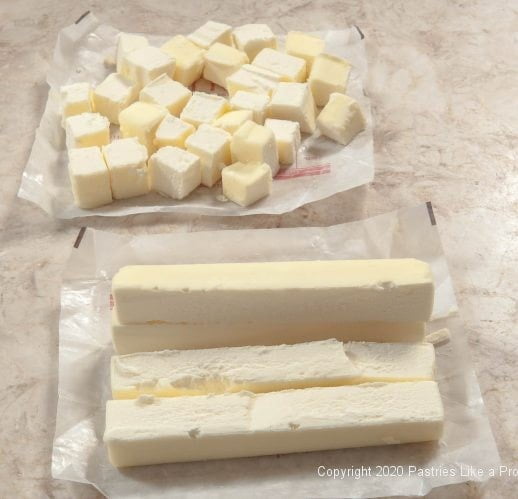
Cakes – Generally I prefer to make cakes in a mixer. However, there are exceptions.
Orange Almond Teacake.
Cheesecakes - I used to make my cheesecakes in a mixer, but the processor beats any other method. They are creamy beyond imagination and so, so easy to make.
Sour Cream Cheese Cake
Unbelievable Cheese Cake Update
Cold ingredients – should be used unless otherwise specified. This includes cold or frozen butter and cold water when making yeast doughs. The processor creates heat when continuously run. Consequently, room temperature butter makes for pasty pie crusts or laminated dough. When making bread, cold water should be used since the bread will heat up when mixing. If warm water is used in the beginning, it can overheat the bread causing it to rise too fast and change the texture when finished.
Cutting butter into flour becomes super easy when using a food processor. The butter should be cold or frozen depending upon the recipe and cut into small pieces. It is then pulsed into the desired size, larger, irregular chunks for laminated dough, pie crusts or pate brisee or it can be cut in until it is indistinguishable such as making shortbread cookies or Updated Lemon Bars. (see Pie and Pastry crusts below)
Murbteig is a very special German cookie.
Updated Lemon Bars
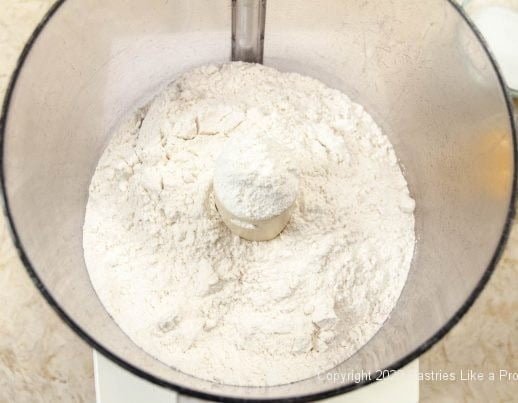
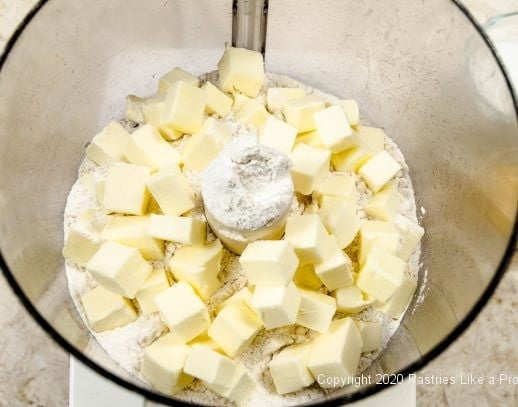
Flour in Bowl.Butter in the bowl.
Butter cut in.
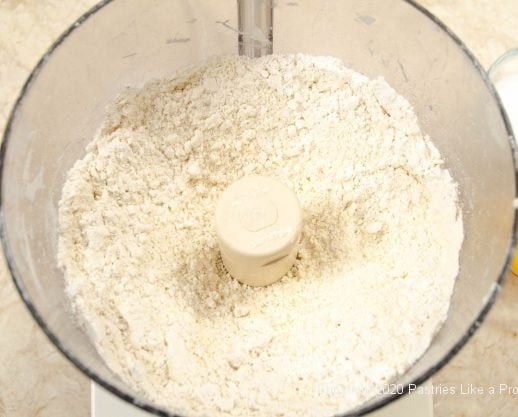
Grinding Grain - I use my processor to grind oatmeal to a powder when making gluten-free recipes.
Nuts – The one thing that I believe processors don't do well is chop nuts. However, if you do want to chop them then toast them first. Cool them completely. Chop small batches at a time, pulsing in 1second bursts. Empty the bowl into a strainer to sift out the really fine powdery nuts if using for decoration. Nut-butters – toast the nuts, cool and place in the food processor. Process continuously, stopping to scrape down the sides until they are pureed. Any nut will do. If the nut butter is too thick, add a bit of vegetable oil along with honey, sweetener or sugar if desired. Another option is to shred the nuts using the shredding blade. Simply pack them in the feed tube and, with the machine on, push them through in one fell swoop.
However, if you are chopping nuts to a fine powder, the processor is your tool. In this case, add some of the flour or sugar from the measured amounts in the recipe to keep the nuts from turning into a paste. If no flour or sugar is being used, pulse the nuts to break them up into really small pieces and then pulse them to the desired fineness.
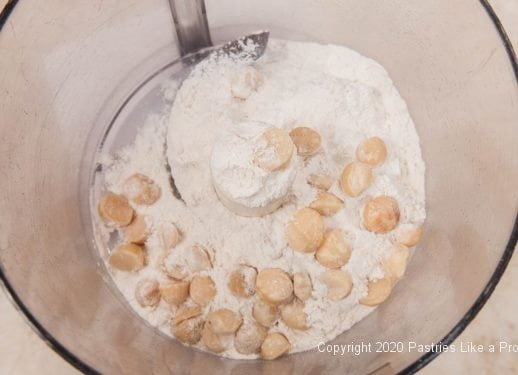
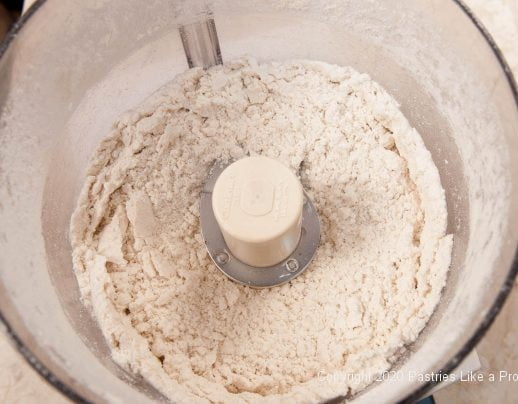
Pie and Pastry Crusts are really easy to make in a processor. The cold butter is cut into the flour followed by the liquid being poured down the feed tube or simply over the ingredients in the bowl. The key is to not let the mixture ball up. Keep it loose and bring it together after it has been removed from the processor.
American Pie Crust Tutorial
Peach Pizza featuring the French crust Pate Brisee
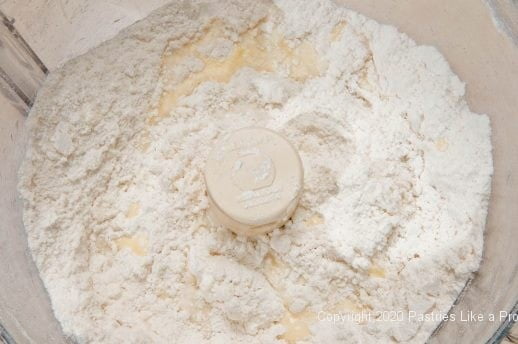
The liquid in the butter/flour mixture.
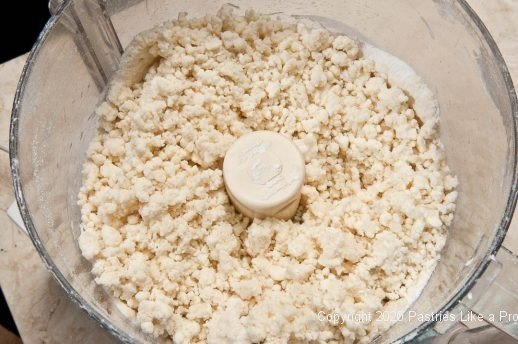
Pulsed to form large crumbs.
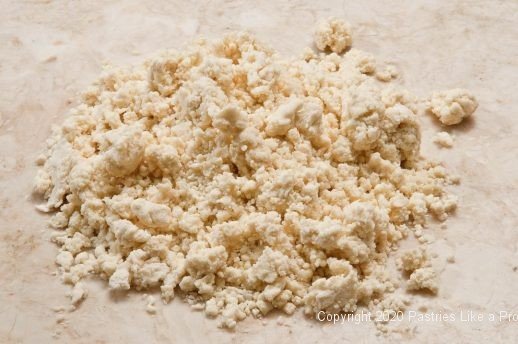
Poured onto the work surface.
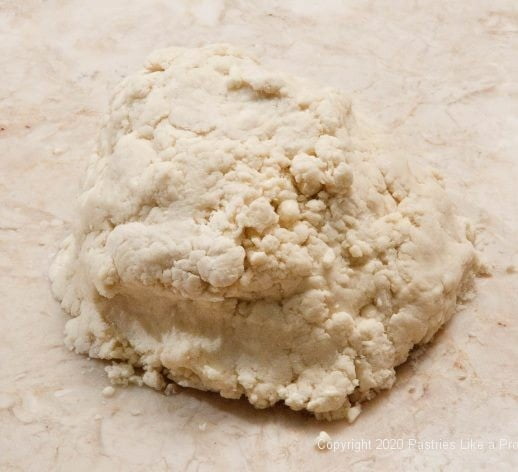
Pushed together.
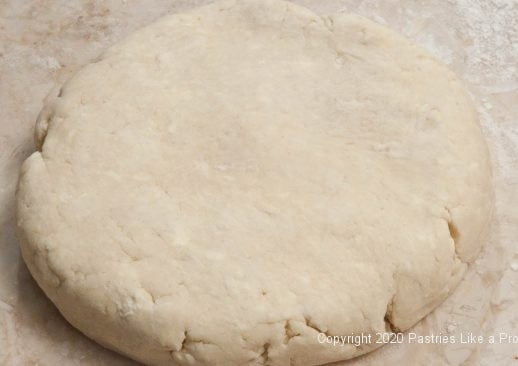
Shaped into a round.
Redistribute the contents and scraping down. Redistributing the contents of the processor is sometimes necessary for even mixing. If it is liquid, stir it. A heavy dough, such as bread or cookies should be torn apart in 3 or 4 pieces and placed around the blade in a circle and processed again. This also works if the ingredients don't move anymore while processing.
The bowl of a food processor should be scraped down just as when using a mixer.
Superfine sugar – When making meringues, angel food cake, or anywhere where the sugar needs to dissolve completely, superfine sugar should be used. It can easily be made by taking regular granulated sugar and processing it briefly. This works great and is easily done. I keep a jar of superfine sugar in my pantry so I don't have to do it every time I need some. If you have leftover vanilla bean pods bury them in the sugar for a wonderfully scented vanilla sugar.
Whipped Cream – technically the food processor whips cream but it is much denser than whipped cream in a mixer because it can't aerate mixtures as can a mixer. It can mix, chop, and puree, but it can't whip. Pour 1 ½ cup heavy cream in the bowl of the processor. Add ⅓ cup powdered sugar (45 grams or 1 ½ ounces) and 1 teaspoon vanilla which is optional. Process to the desired peaks. However, be very careful not to overprocess or you will have sweetened butter.
Cream and sugar in the bowl.
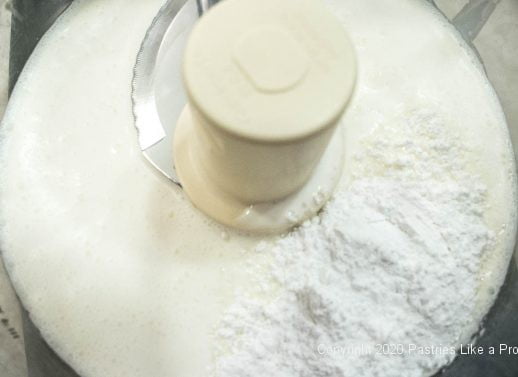
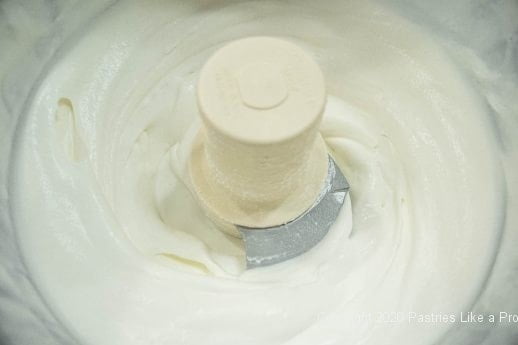
Whipped to soft peaks.
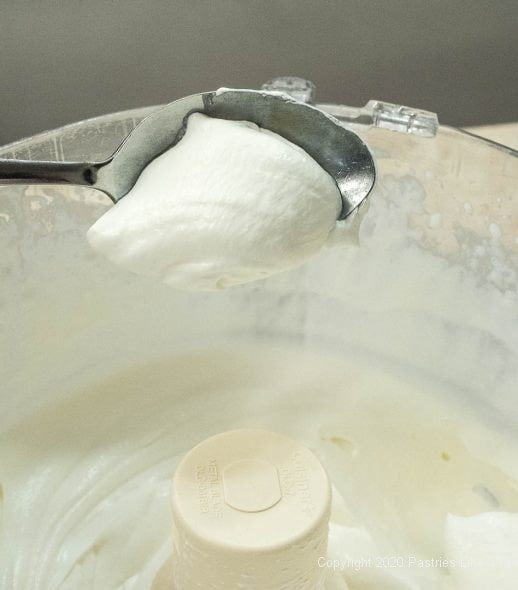
Cream beaten to soft peaks on a spoon.
Stiffly whipped cream.
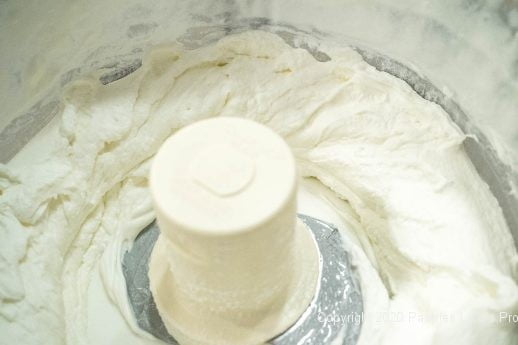
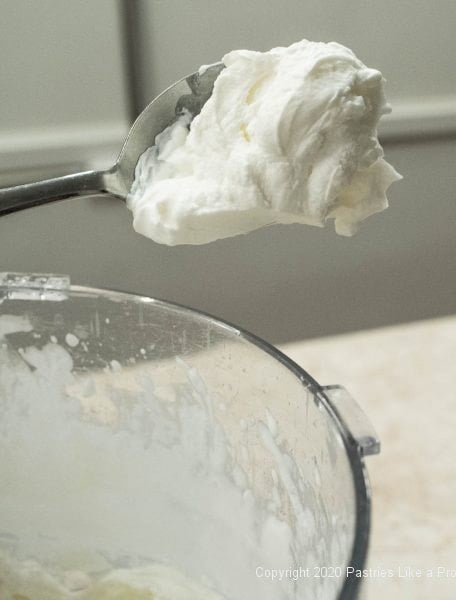
Stiff cream on a spoon.


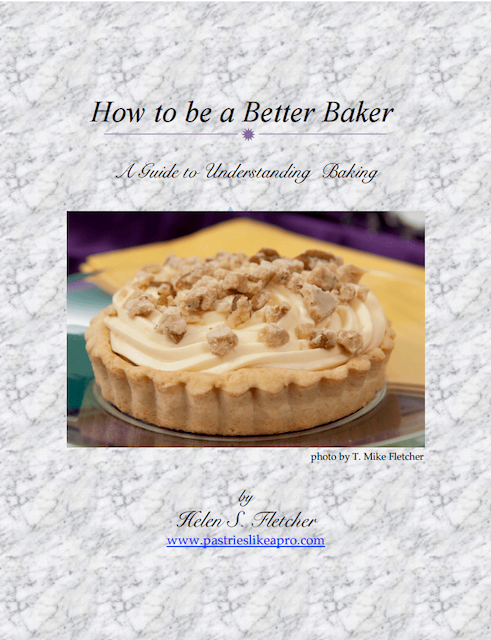

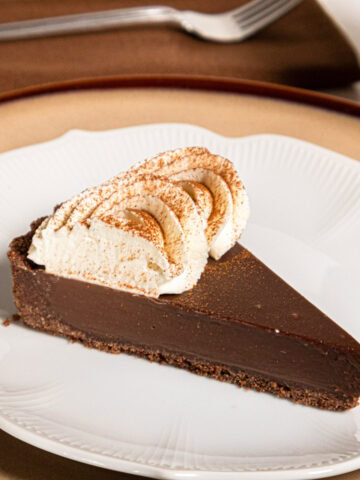


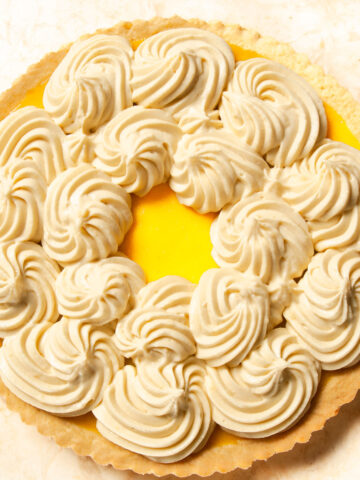
Terry Buxton says
Helen,
Kudos for this very informative article. I purchased the original smaller version of the Cuisinart when it first came on the market many years ago, and not long after the larger Robot Coup because the smaller machine was too small for what I was doing. Both are still in use and the only replacement in all of these years was a new bowl for the Robot Coup. The stainless S blade for the latter is not as sharp as it once was but is still very usable for what I do these days which is mostly for baking.
Love your website. I enjoy baking your recipes for friends and neighbours who always enjoy eating them. Thank you for sharing so much of your baking knowledge and recipes. I frequently refer younger homemakers to your website because you share so much valuable baking information, and such good recipes. Unfortunately I have had to eliminate sugar from my diet in my later years but I do on occasion sneak a bite or two when baking a new recipe from your site.
Thank you for your generosity in sharing so much. I am certain it is much appreciate by many.
Helen S Fletcher says
Dear Terry, What a wonderful way to close out the day. I appreciate you taking the time to send this. I agree the food processors are wonderful and such a boon to bakers. Thank you.
Alberta Parker says
I have 2 Cuisinarts and one of another brand. My older and bigger machine is at least 28 years old and still going strong, although I tend to use my smaller 7 cup machine more frequently (because it fits in the kitchen cupboard). I am a serious home cook and find that I use the machine more often to speed up tasks that I don't enjoy (mincing in particular) and prepare large batches of veggies/herbs to freeze. I always wash in the dishwasher and have never had any issue with the plastic from detergent. I misplaced my plastic blade and thought that I shouldn't use the metal one for cakes, so thank you for assuring me all is good when using the metal blade.
I love your site for your clear instructions and professional tips. Thank you for providing a site for serious cooks without the "cuteness" of the tv chefs.
hfletcher says
Thanks so much, Alberta. I appreciate your thoughts.
Maria says
I have the 14 cup as well, last of the old style. It came with mixer beaters as well, but I’ve never used them. Mostly I use it for pie crust. It’s fantastic for that. I always wanted to chop uniform onions, but never figured it out.
hfletcher says
Oh Wow Maria - that is one of the old ones. The beaters were never that successful which is why they aren't included anymore. Cutting the onions in large pieces then pulsing in 1-second bursts will give you the best result with the onions. They will never be perfect, but it is so much easier than chopping by hand.
Elaine K. Wallace says
I've loved my kitchen BFF for years. Your article was so spot on. I learned tips that I did not know...how to clean the blade who knew?? Whipped cream? yes and I too have made weet butter. but it always came in handy,
thank you so much for the great article for a great machine.
hfletcher says
Hi Elaine - so happy to help.
Ellen says
I got my first Cuisinart about 36-37 years ago and I love it. These are great tips--I wouldn't have thought yeasty things would work. Never even thought about whipped cream. It does get a regular workout for pie crust! Thanks for a great article, Helen.
hfletcher says
Hi Ellen - There is so much the processor can do. I don't think I could bake without it.
Barbara Malewska says
Thank you for a great article. I have an early version of the Cusinart processor and also a 20 yr. old mini - both used frequently. I also have 2 of the early Abby Mandel cookbooks and that is how I learned to use the processor.
I have been whipping cream in the processor for a long time - the mini - and had to learn how long to process. I have, in the past, made butter!!!
Thank again, I love your site and learn much.
hfletcher says
Hi Barbara, I love the butter note. I once whipped 16 quarts of cream and turned them into butter. Fortunately, we used it in all kind of recipes at the bakery. All you have to do is turn your back too long!
Susan A Wilkinson says
Hi Helen,
Love your website and always look forward to your recipes and helpful tips.
I still have my original Robot Coupe processor dating back to the late 70's. It was a deluxe set that came with every size blade and attachment you could imagine. Alas; many of the blades have crumbled over the years due to the age of the hard plastic. Replacement blades/attachments are very hard to come by these days. Sometimes, I will find something in a thrift store.
I still use my processor to make pizza dough and grind things. I still love it and have held out all these years from replacing it with something new.
Sincerely, Susan W.
hfletcher says
Hi Susan - Wow! A Robot Coupe. The good thing about processors is they do last a long time - better than most cars for sure.
Sandra Baik says
Thanks Helen! Great article and pics were really helpful. I learned a lot. Love your cranberry chocolate tart recipe!
hfletcher says
Hi Sandra - When the food processor came out, there was a ton of help. Now it's expected everyone knows how to use it. All of these tips came about when I was working with them. Glad it helped. You picked one of my favorites to love.
sallybr says
You outdid yourself in this one, Helen.... so cool also to get a glimpse of your professional career through the invitation to be a consultant -
I use the food processor to make my default pizza dough, which I don't even need the recipe in front of me anymore, it is so so easy, and I don't even mind washing the processor after (a complain that many people have, and I find a bit silly, the benefits outweigh the drawbacks by a huge shot) -
I really need to explore the cheesecake world with it - will definitely do so!
hfletcher says
Hi Sally - I agree about washing it, although I try to plan it so it ends up in the dishwasher. My mother was a fantastic cook and even better baker. I was eating croissant, shaum torte, and so many other European pastries before anyone over here ever heard of them. I can only imagine how much she would have enjoyed this piece of equipment.
Carolyn says
Awesome article. I have had a few food processors through the years. Last year, after my (really expensive) KitchenAid food processor died, I bought a Cuisinart (same model as you said you currently use) and it is hands down the best ever.
You reference your croissant recipe using the food processor. Is it published on this website?
hfletcher says
Hi Carolyn - yes, the recipe is on the blog. Just click on the blue Croissant and it will take you there.
Mari says
What a fabulous article!!! I’ve been using the Cuisinart processor since it became available to general public, too long ago to remember when it was, seems I’ve always had it. I learned new uses with this article. Thanks so much. I’m going to try my yeast breads in it ,thanks to you. Another Winning Article!!
Bonnie Ward Knight says
This article should be provided by the manufacturer to purchasers of food processors. I started with a robot coupe in about 1981, and am now using a Cuisinart. I completely agree with your points about the plastic blade. I am looking forward to trying your laminated dough and making croissants for the first time. I enjoy your well-written posts and the photos very much. And your directions are very clear. Thank you for sharing your knowledge.
hfletcher says
Thank you Bonnie for your very kind words. I love to help people get more out of baking and perhaps, start baking. It is more exacting than cooking, but that precision is the key to success, especially with a scale.
hfletcher says
Thanks Marilyn. I don't know how I would bake without mine. It's like having an assistant in the kitchen.